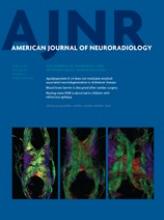Index by author
Nadgir, R.N.
- Head and Neck ImagingYou have accessQuantitative MRI Analysis of Craniofacial Bone Marrow in Patients with Sickle Cell DiseaseE.J. Elias, J.H. Liao, H. Jara, M. Watanabe, R.N. Nadgir, Y. Sakai, K. Erbay, N. Saito, A. Ozonoff, M.H. Steinberg and O. SakaiAmerican Journal of Neuroradiology March 2013, 34 (3) 622-627; DOI: https://doi.org/10.3174/ajnr.A3240
Nagot, N.
- FELLOWS' JOURNAL CLUBNeurointerventionYou have accessEvaluation of an Intravenous-Endovascular Strategy in Patients with Acute Proximal Middle Cerebral Artery OcclusionJ.-F. Vendrell, R. Mernes, N. Nagot, D. Milhaud, K. Lobotesis, V. Costalat, P. Machi, I.L. Maldonado, C. Riquelme, C. Arquizan and A. BonafeAmerican Journal of Neuroradiology March 2013, 34 (3) 603-608; DOI: https://doi.org/10.3174/ajnr.A3230
Here, the safety and efficacy of mechanical thrombectomy after intravenous therapy failure were assessed in 123 patients with acute MCA occlusions. All patients imaged were within 4.5 hours of onset, had DWI ASPECTS greater than 5, and variable NIHSS scores (8–25). The authors found that mechanical thrombectomy after failure of intravenous thrombolysis improves clinical outcomes at 3 months and could represent an alternative in the management of patients with acute MCA occlusion. Additionally, no symptomatic intracranial hemorrhages were detected in patients treated this way, suggesting this protocol is safe.
Nakata, Y.
- BrainYou have accessPostoperative Transient Reduced Diffusion in the Ipsilateral Striatum and ThalamusK. Kamiya, N. Sato, Y. Nakata, K. Ito, Y. Kimura, M. Ota, A. Takahashi, H. Mori, A. Kunimatsu and K. OhtomoAmerican Journal of Neuroradiology March 2013, 34 (3) 524-532; DOI: https://doi.org/10.3174/ajnr.A3242
Nascene, D.
- Pediatric NeuroimagingOpen AccessChildhood Cerebral X-Linked Adrenoleukodystrophy: Diffusion Tensor Imaging Measurements for Prediction of Clinical Outcome after Hematopoietic Stem Cell TransplantationA.M. McKinney, D. Nascene, W.P. Miller, J. Eisengart, D. Loes, M. Benson, J. Tolar, P.J. Orchard, R.S. Ziegler, L. Zhang and J. ProvenzaleAmerican Journal of Neuroradiology March 2013, 34 (3) 641-649; DOI: https://doi.org/10.3174/ajnr.A3232
Nghiemphu, P.L.
- EDITOR'S CHOICEBrainYou have accessProbabilistic Radiographic Atlas of Glioblastoma PhenotypesB.M. Ellingson, A. Lai, R.J. Harris, J.M. Selfridge, W.H. Yong, K. Das, W.B. Pope, P.L. Nghiemphu, H.V. Vinters, L.M. Liau, P.S. Mischel and T.F. CloughesyAmerican Journal of Neuroradiology March 2013, 34 (3) 533-540; DOI: https://doi.org/10.3174/ajnr.A3253
Images from over 500 patients with glioblastoma were used to build location atlases corresponding to genetic and biologic abnormalities as well as prognosis based on age. Most glioblastomas grew into the periventricular regions adjacent to the subventricular zone. MGMT promoter methylated tumors occurred more frequently in the left temporal lobe in young patients, in IDH1 mutant tumors, in those having the proneural gene expression subtype, and in tumors lacking loss of PTEN that occurred most frequently in the frontal lobe. MGMT methylated tumors with IDH1 mutation tended to occur in the left frontal lobe. EGFR amplified and EGFR variant 3-expressing tumors were found most frequently in the left temporal lobe. Tumors in the left temporal lobe were associated with favorable response to radiochemotherapy and increased survival.








